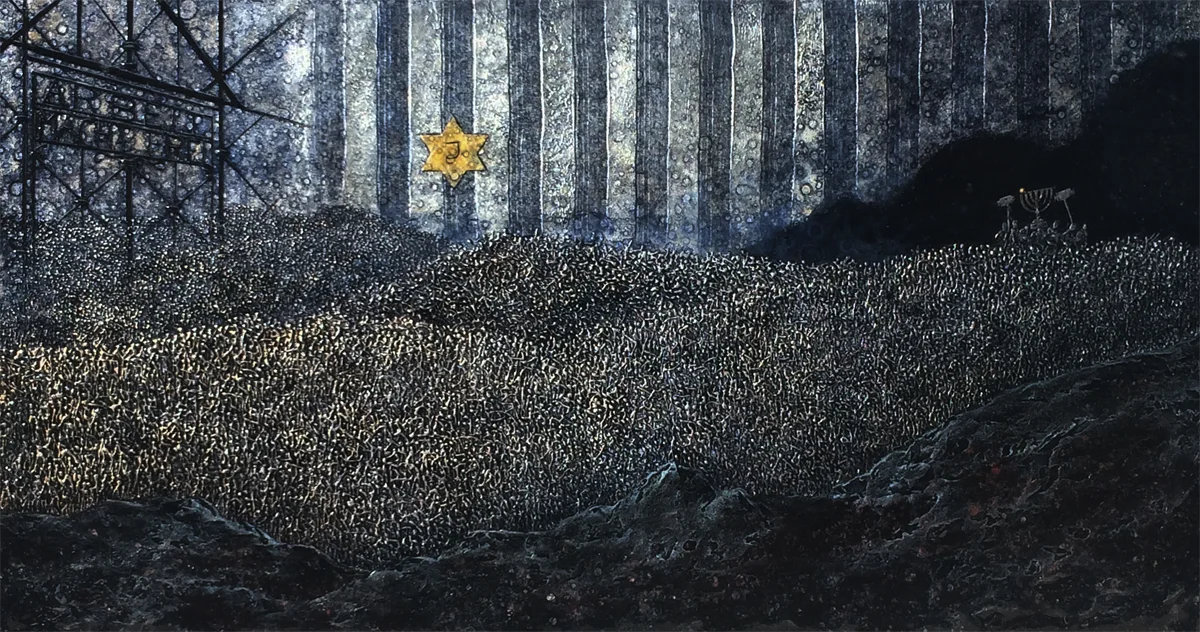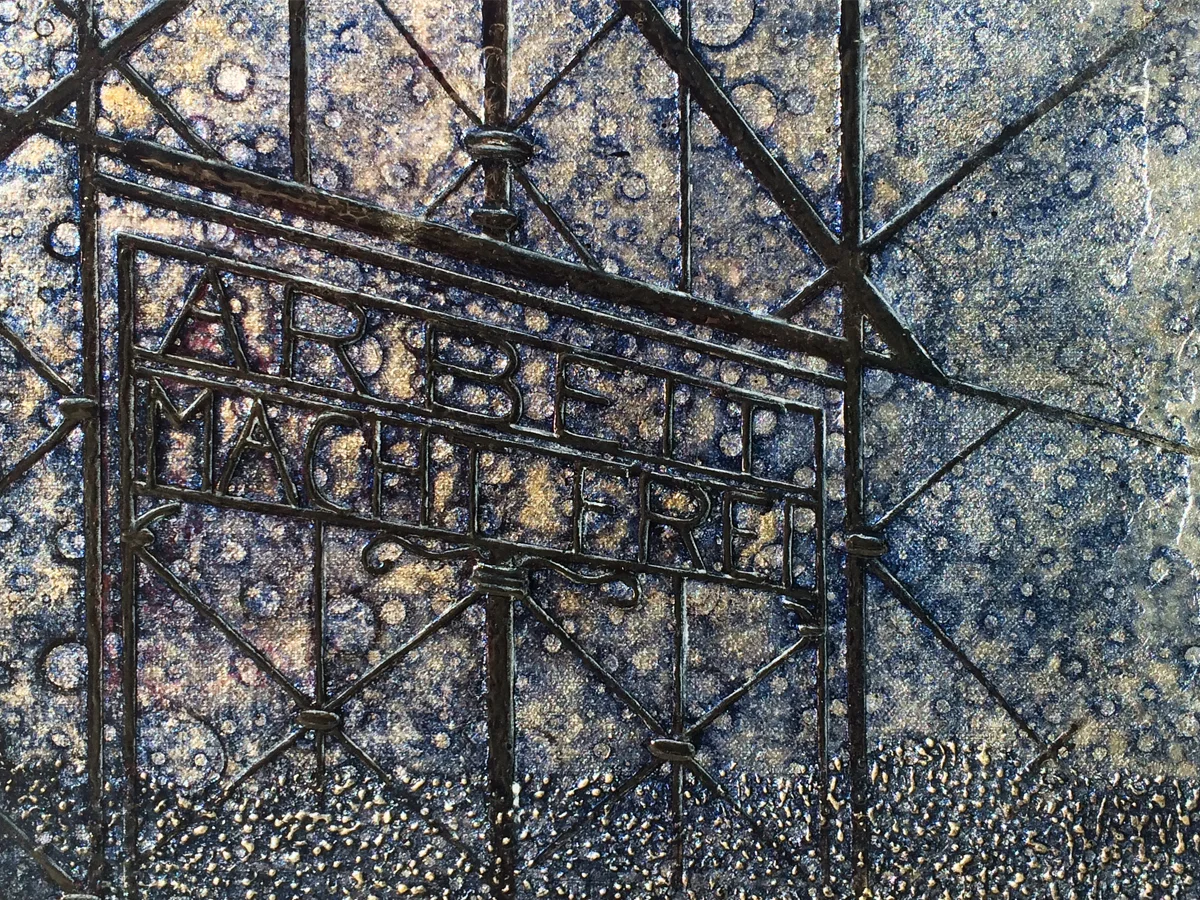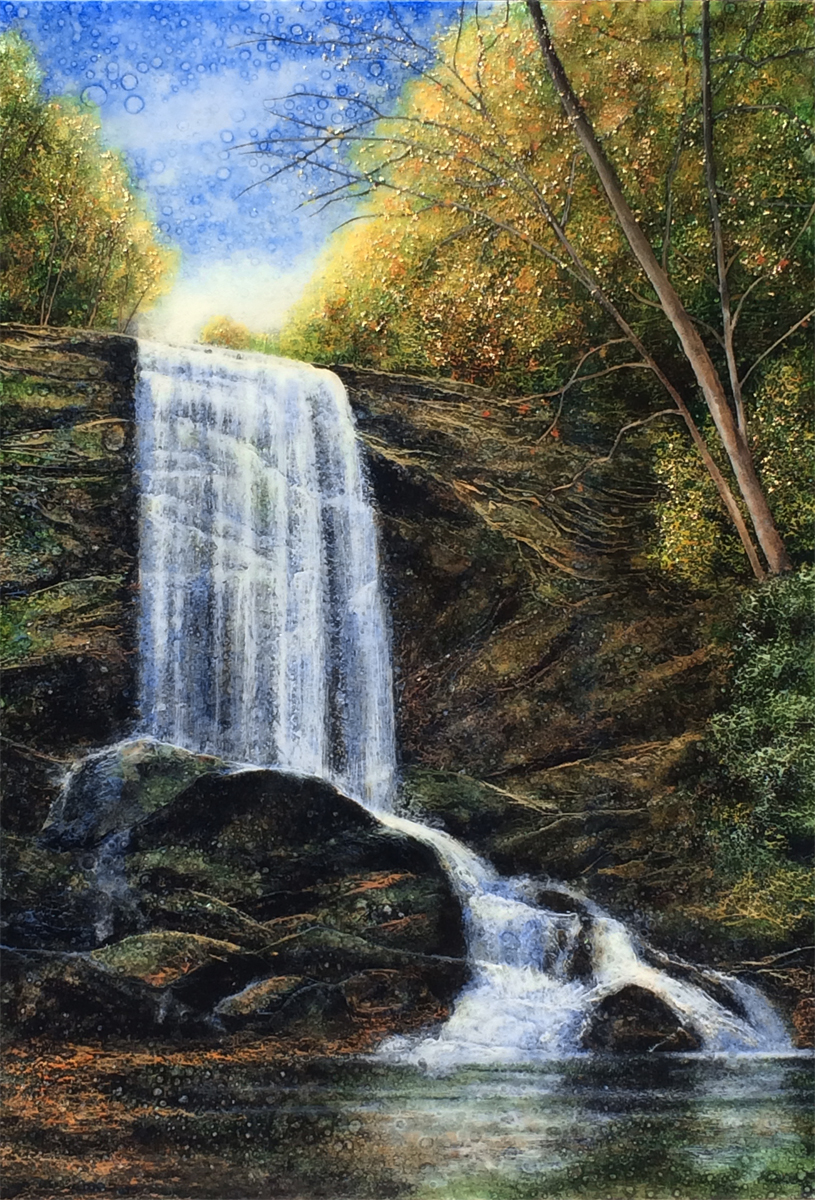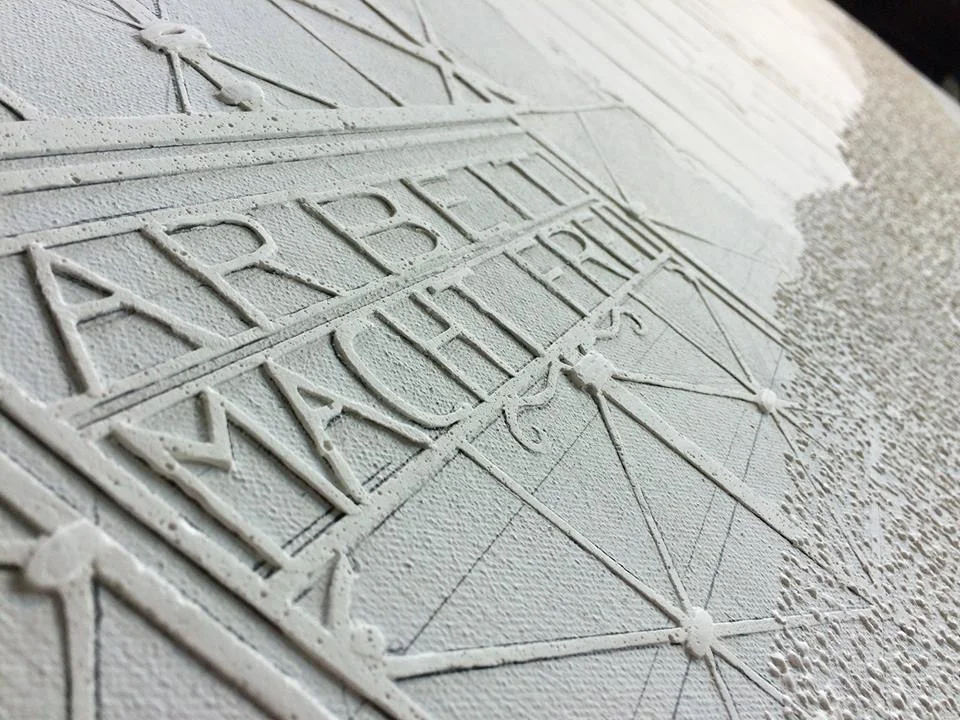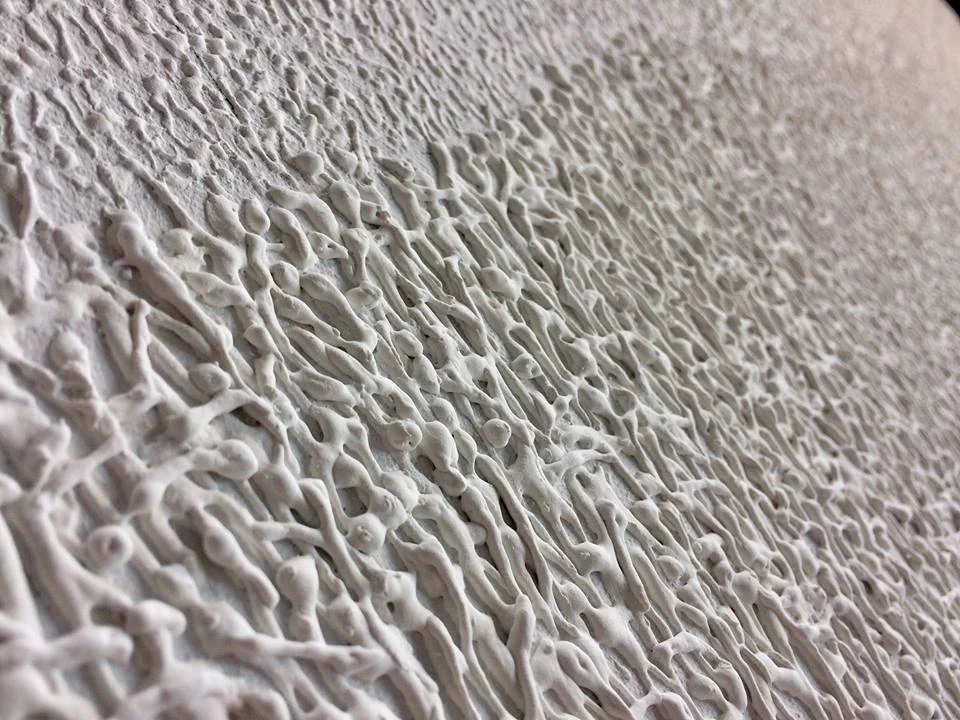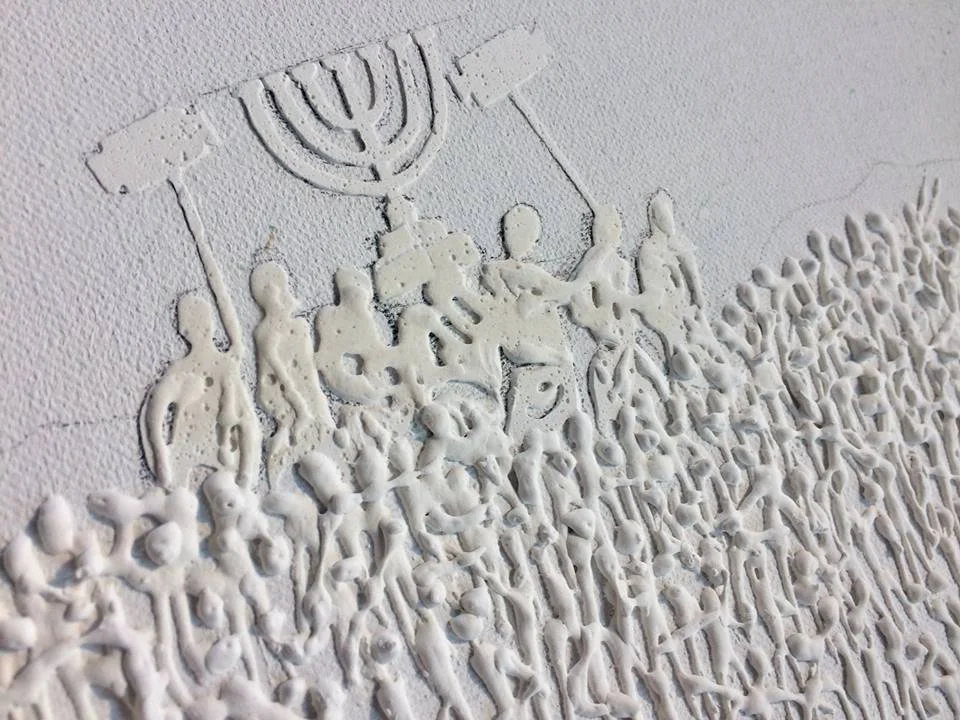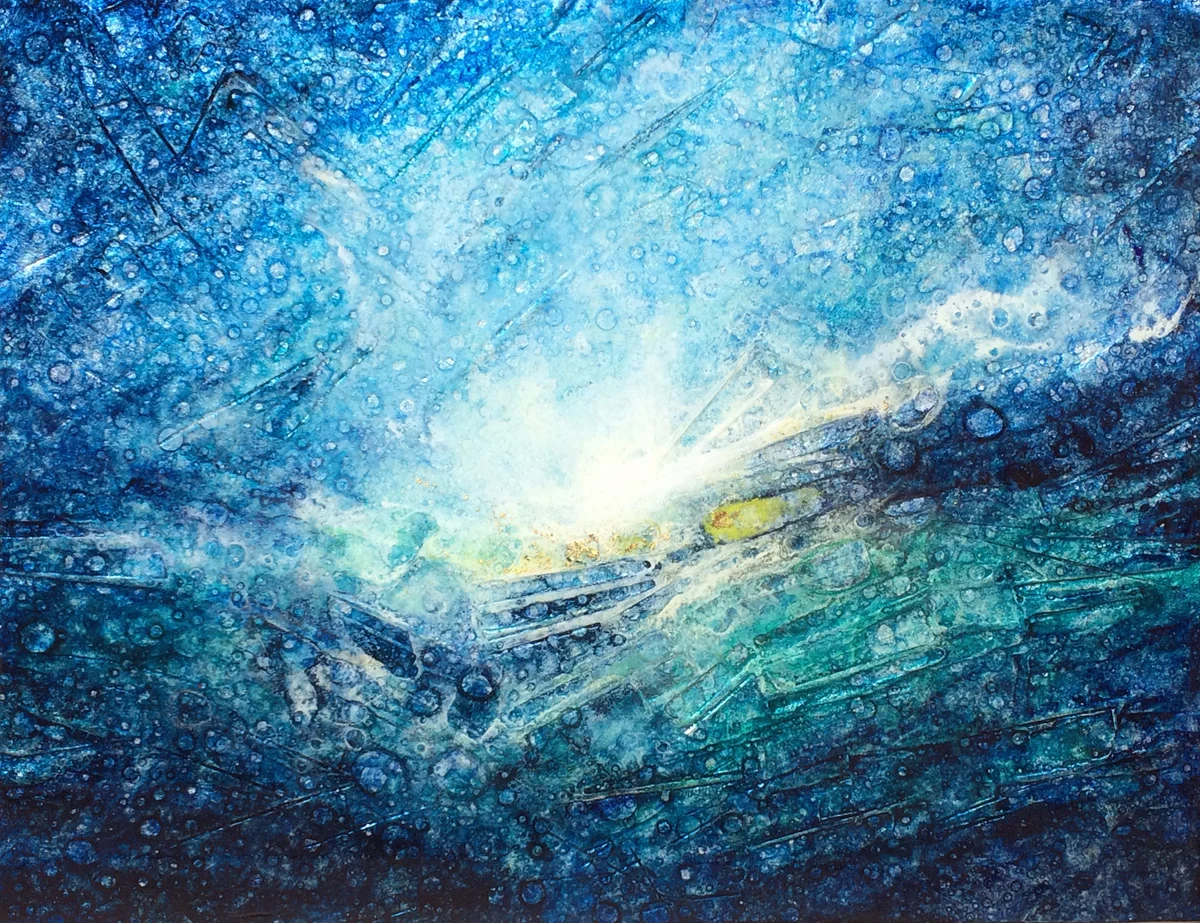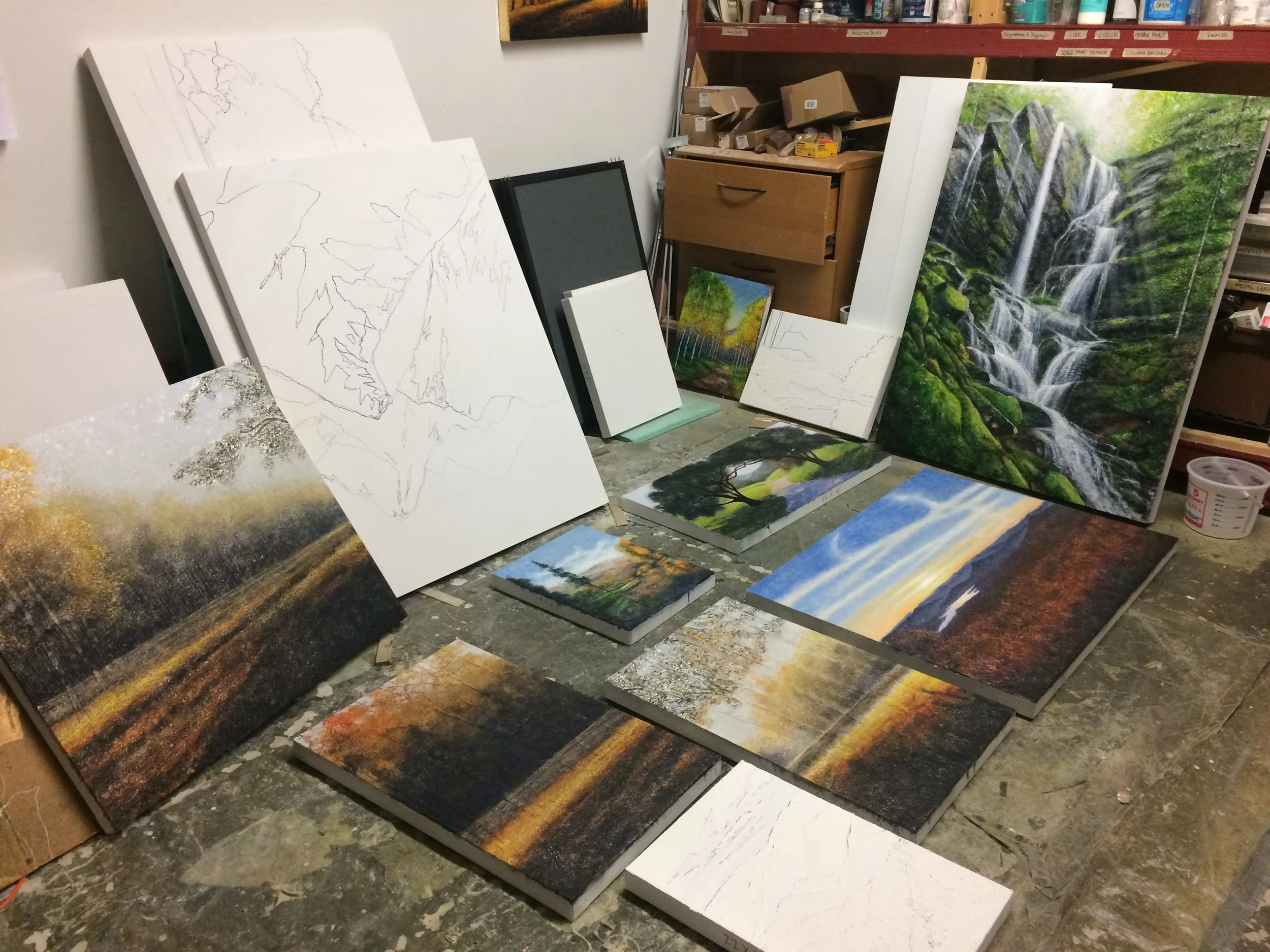
Art Blog
This blog is for posting photos of new artwork and for the expression of sometimes random thoughts of oil painter Stephen St. Claire.
"Valley of Shadows"
Valley of Shadows
In September 2017, Joy and I visited a good friend in Munich, Germany. While there, we explored what is left of the concentration camp at Dachau. Nothing could have prepared me for what I saw and felt.
Visitors to Dachau are very quiet. It's a horrible and holy place. The weight of the evil is still there. You can still feel it. I think it will always be palpable. It should be. I left Dachau needing to express my own grief. This painting is that expression.
Notes about Valley of Shadows
1) Featured on the far left of this piece is the iron gate with the words "Arbeit Macht Frei" (Work Makes you Free). This gate was the way in, but rarely the way out.
2) Moving to the right, set against and gray and blue stripes reminiscent of the uniform prisoners were given to wear is the gold star of David, beneath which are the countless souls who suffered here.
3) Moving to the far right, I inserted a scene from the Arch of Titus in Rome, featuring Roman soldiers carrying off the menorah from the temple in Jerusalem (another time of absolute grief and horror). It is at this point, against the blackness, I inserted a symbol of hope. Hope is displayed near the far right of the canvas, carrying the eye off the artwork...onto...what? That is what hope does -- carries our imagination into the unknown, with the assumption that goodness and beauty and life is coming soon.
"Even when I walk through the Valley of the Shadow of death,
I will not fear, because You are with me.
Your rod and your staff, they comfort me." Psalm 23:4
Forest of Autumn Gold
Living in Asheville, North Carolina as an artist in the River Arts District, I don't see many birch trees in the woods around here. Western North Carolina has river birches and they're nice and all, but we do not have proper "paper birch" trees. Thankfully, I don't have to just paint local scenes (though I do end up celebrating the mountains and trees of the Blue Ridge and Appalachian Mountains more than anything else). This painting, "Forest of Autumn Gold" is based on my memories of a certain October thirty four years ago when Joy and I visited the state of Maine on our honeymoon. Birch trees (proper paper birch!!) were everywhere. I remember the sound of the leaves in the wind roared like a waterfall. So beautiful.
Birch and aspen trees are magnificent in art. I lump them together simply because with my somewhat impressionistic style, I paint both birch and aspen trees in a similar manor. They are graphically perfect! Black on white. What a great design!! And they stand out against the foliage perfectly in any season. Seriously, in winter, spring, summer or (especially autumn), the tree trunks of the birch or aspen trees always stands out against the color of the leaves. Think about it...what other tree trunk steals the thunder of it's leafy canopy like birch or aspen? Okay, the Sequoia Gigantia in California probably wins but that's the only other tree that does.
So I celebrate the beauty of autumn in Maine (or Colorado, depending on whether you see these as paper birch or aspens). Either answer is correct. Cheers!
Then and Now
A few weeks ago, I was staring at (in my opinion) one of the most beautiful statues in the world, Michelangelo's "David". The piece is absolutely astonishing. At the Galleria dell' Accademia in Florence, there are several other statues by other artists and I could not help but compare them to David. The difference is astonishing. The other pieces I saw were beautiful and skillfully worked, but in no way could be compared to David. Other pieces had arms but David had blood vessels and sinews. David is nearly alive. The skill to create such a masterpiece is mind boggling. That much is patently obvious.
Michelangelo's "David"
As opposed to the "victory pose" over the fallen giant Goliath, Michelangelo's David appears to depict the youth just moment after he has made the decision to fight giant but before the battle has actually taken place, a moment between conscious choice and action. His brow is drawn, his neck tense and the veins bulge out of his lowered right hand. His left hand holds a sling that is draped over his shoulder and down to his right hand, which holds a rock. The twist of his body effectively conveys to the viewer the feeling that he is in motion, an impression heightened with contrapposto (an asymmetrical arrangement of the human figure in which the line of the arms and shoulders contrasts with while balancing those of the hips and legs). There is your art history "lesson of the day". This classic pose causes the figure’s hips and shoulders to rest at opposing angles, giving a slight s-curve to the entire torso. The contrapposto is emphasized by the turn of the head to the left, and by the contrasting positions of the arms.
Compare and think...
So that was then, this is now. Times change I guess. See, when I got back home to the States, I saw a poster of a statue Picasso had created and I could not help but compare it to David, just as I compared the other statues I saw in Florence. So here's a good little exercise for you: Compare and think. What are you thinking? (I'd really like to know.)
Pablo Picasso's "Petite fille sautant a la corde"
Here is what High Five magazine says about Picasso's sculpture:
"Pablo Picasso's work remains astonishing. It is not limited to painting. The incursions of the Spanish master, especially in sculpture, produced admirable results."
"Before 1950, when the "Petite fille sautant à la corde" (or "Little Girl jumping rope) was completed, the practice of sculpture in Picasso seems episodic, according to the pictorial reinvention that crosses his work. Having no training in construction, unlike a classical training in painting, the sculpture remains for Picasso a hobby (if I may say), as a fun place to express his free creativity."
"Although Picasso prefers to use his brushes, he remains an inventive sculptor, motivated by the desire for experimentation. Picasso is a man constantly torn by the need to rebuild. He is reappropriating formal objects, technical innovations and artistic breaks to give his work a new impetus."
Catawba Falls
I love Catawba Falls. It's a really beautiful waterfall at the end of a (sometimes steep) trail just down the mountain from us in Old Fort, North Carolina. The trail winds along the river and ends at a cliff and this really beautiful waterfall and pool (great for swimming in summer by the way).
Joy and I discovered Catawba Falls with the help of my daughter Camden. She had hiked here before and told us about the trail so...we had to discover it ourselves. This is one of countless waterfalls within an hour of our home here in Asheville. What an amazing thing it is to be a landscape painter in the River Arts District, so close to so much...uh...landscape! We try to get out and hike every day off (weather and house chores permitting).
This painting was commissioned by some very nice folks (Asheville locals) who came into my art studio and asked a question I LOVE to get asked: "Do you do commissions? We have a specific photo of a very special place to us". I love that. Of course, I was excited to talk to them about the project (about half of what I sell are commissions). I love commissions for many reasons. They are a pre-paid painting so uh, that's nice. But it's also a great way to not only get a nice piece of art (I'll keep painting it until it IS a nice piece of art) but it's also the opportunity to create something sentimental to the client. I've painted photos from honeymoons and vacations all over the world.
So...Catawba Falls is done and is to be picked up this week. If you want directions to the trail, just email me or swing by my Asheville studio. Cheers!
"Valley of Shadows"
"Valley of Shadows" is taking shape, and it is haunting. This is really the most difficult piece I've ever done. I find I can only work on it for about 20 minutes at a time. The texture is nearly laid and should be ready to cover with the aluminum leaf shortly. I really enjoy painting beauty and this is not beautiful at all. I hope it's powerful though.
I find it difficult to interact with people coming into my River Arts District studio while I'm working on this piece. Seriously! "Oh!" says some woman from any random state in the U.S. upon entering the studio. "Look George! The artist is working!" (This is my studio. Of course I'm working.) "What are you working on?" she asks excitedly.
How do I explain what I'm working on? "Well, I'm depicted corpses at the moment". What do I say? I try to work on this first thing in the morning, before many people are wondering in. Folks, this is really difficult.
Everything else I paint, I am completely fine with being interrupted with questions and with people coming around my desk for a closer look at what I'm working on at the moment. This one is different. I feel like the time I am working on this is holy. Truly sacred. I don't want it interrupted.
So if you're reading this and you're a recent early morning visitor to my studio and wondered why the artist was so aloof and in his own little world, well...now you know. I apologize. I really was in my own little world, but I had to be there. I had to be focused. I had to listen in my head. So difficult. I would much prefer painting mountain scenes around Asheville.
Autumn River Song
"Autumn River Song". This was a fun one. A while back, I had a gentleman visit my art studio in Asheville's River Arts District and he spent a good deal of time wandering around studying my artwork. We had a really nice conversation and then he left, taking a card. This was not that unusual. Visitors to the art studio take a LOT of business cards and that's cool. That's what they're there for. But this guy called back a few days later and said he wanted to surprise his girlfriend with a painting of mine. That made my day. I love commissions!
He got on my website and found an older painting of mine that he liked, but wanted a few things changed. Here's the original painting:
He asked that some of the rocks be removed from the right side and replace the foreground rocks with new moss-covered rocks. And he wanted autumn colors rather than summer greens. I love commissions! And I love it when a client feels the freedom to get involved (he actually spent a good deal of time hunting for the foreground rocks he wanted).
I love revisting a painting I enjoyed the first time, and tweaking it, creating a brand new and unique piece of art. It's like taking leftovers of a great leg of lamb and potato dinner and making stew out of it, you know? It's like and unlike the original "go-round". I once heard that there really is nothing unique, just unique ways of re-combining preexisting elements, and I think that's right. How many ways can just four elements (ADTP for instance) be combined and recombined to create over 7,000,000 unique individual people? I think this really does apply to art. How many times did Monet paint waterlilies or St.Paul's cathedral? Countless. But each one is unique and he obviously revisted the idea because it gave him joy. That's how creativity works.
And when I see this new piece that combined old and new ideas, it gives me a great deal of joy. That's why I paint. So if you're considering commissioning a unique oil painting, let's talk! It's a blast.
Autumnal Shift
Abstract oil paintings are always mysterious to me. I have a vague idea of the color palette I want to use, but honestly, I have no idea what I'm doing. That's what I enjoy about painting an abstract piece. The piece itself really kind of evolves by itself and I sometimes just feel like I'm only involved in the gentlest of ways. I tell people painting an abstract painting is like raising a teenager -- you might as well not even bother trying to make it this or that because in the end, it kind of makes up its own mind. It's good for us control freaks to paint abstract art I think.
This painting entitled "Autumnal Shift" (thank you to Kris Archbold on my Facebook feed for the title!). It has a lot of texture -- vertical and horizontal scratches and raised areas, and then finished with just a bit of judiciously applied gold leaf.
When I posted the photo of this piece on my Facebook page, I asked people what they saw, and what it should be named. It was an interesting and very well received little exercise. People saw a city scene on a river, tall ships and hilltops on fire. That's what I like about abstract art. It's almost like staring at the clouds -- abstract invites the participation of the viewer. "What is it?" you ask. Ahhh -- now I've got you. You must get involved and figure it out. What is it? What do you see?
“Abstraction allows man to see with his mind what he cannot see physically with his eyes....Abstract art enables the artist to perceive beyond the tangible, to extract the infinite out of the finite. It is the emancipation of the mind. It is an exploration into unknown areas.” -- Arshile Gorky
Mystic Summer Morning
"Mystic Summer Morning" (30" x 24") is a summer version of an autumn scene I've done before, and it's reminiscent of most summer mornings here in Asheville. Oftentimes because of thunderstorms the afternoon before, mornings can be rather foggy. That fog burns off usually by 10:00 or shortly thereafter, and then it's clear for just a bit. That fog then gathers into cumulous clouds and then becomes an another afternoon thunderstorm. But in the morning, that fog softens everything and dampens all sound.
I make it a habit of walking the 3 miles to my art studio in Asheville's River Arts District every morning (and then back again at night) but on foggy, cooler summer mornings, there's a longer route I can take that eventually leads right along the French Broad River. It's a very quite walk and when I need some extra rejuvenating and the weather is right, I walk the extra miles. It's so worth it. Before that trail gets to the river, it goes through quite woods and on foggy mornings, it's mystical. It's really beautiful that time of day. I love Asheville!
Valley of Shadows
While we were in Germany the last couple of weeks, one of the things I needed to do was to visit what remains of the concentration camp at Dachau, just outside of Munich. I needed to see it because several weeks ago, a gentleman visited my Asheville studio and asked me to consider doing a painting commission based on the Holocaust, which was the strangest and most daunting request for an art commission I'd ever received. But I felt like this was something I needed to do.
The commission itself did not work out, but the idea was planted in my head and it's been growing. It will be dark and disturbing, but artists before me have depicted dark and disturbing subjects before (Goya comes to mind). So I wanted to visit Dachau (since it's so close to Munich where we were staying) and soak it in -- let it do in my heart whatever it wanted to do so that I could then depict that in my future painting.
It was not pleasant.
The only way I could take it in was to not fully take it all in. I don't know how anyone can "fully" take it in. I felt myself hardening while I strolled slowly through the grounds. Row upon row of barracks foundations still stand, and I felt a horrible weight. I've never felt anything so miserable and dark and dreadful before.
Row upon row of barracks.
Close your eyes and you still can't imagine the pain of the place. These were real human lives and I wanted to hear them but again, I felt a self-protective "deadening" of my heart. It was the only way I could keep walking; could keep "listening".
It got darker still.
We walked into the very room where people were told to strip. We walked into the next room, tiled floor to ceiling as though it were a shower. I walked into that dark room, silent now but you can still feel a horrible weightiness there. Crushing.
We saw rafters in front of crematory ovens from which people were hung, so that the last thing on this earth they would see would be the open oven door.
No one speaks at Dachau. Communication is in short whispers. It is a holy and horrible place. No one knows how to take it all in and comprehend it. How can you? How can you even begin?
How did this happen? Germany was not a third world country full of back-woods people controlled by superstition. They were a major western civilization, full of creative people. It was a country full of world famous musicians, painters, writers and scientists. But it was a struggling country. They felt like they were not in control of their destiny anymore. They wanted Germany to be great again and they found someone who promised the moon. And then they turned their head when the horrors began to happen. How could this have happened? I think the scenario sounds hauntingly familiar. Similar things could happen anywhere in any generation unless we remember and learn from the past. If you listen, in places like Dachau, the past still has a voice and it is dark and absolutely crushing.
I know now what I need to paint. Some would say it's a waste of time because it may never sell. But art is my voice. And right now, I want to speak.
More to come.
the breakers
"the breakers" (18" x 24")
This was was...uh...interesting. I hear people come in my studio and say silly things to each other like "well remember, there are NO MISTAKES in art". Rubbish. I've made them all. I originally started this one several weeks ago and I liked the idea: very subtle gray, dark, muted colors. Anyway, it should have been hanging on my wall this last month except I was so disgusted with the original version of it that I took my paint-thinner soaked rag to it and wiped off as much paint as I could, then completely re-covered it with aluminum leaf and started over. This time, I switched gears and went with aquatic colors. As usually, I had no idea what was going to happen in this abstract as it progressed, but the very last day of paint application, it took the form of an abstracted seascape: waves crashing. I was very happy.
So the next time you hear someone say something ridiculous like "there are no mistakes in art", just butt in please and tell them "uh...you mean there are no mistakes that can't be corrected". Happily, most "mistakes" can indeed be remedied with some grit and determination.
So enjoy "the breakers".
The Three Voices
by Robert W. Service
The waves have a story to tell me,
As I lie on the lonely beach;
Chanting aloft in the pine-tops,
The wind has a lesson to teach;
But the stars sing an anthem of glory
I cannot put into speech.
The waves tell of ocean spaces,
Of hearts that are wild and brave,
Of populous city places,
Of desolate shores they lave,
Of men who sally in quest of gold
To sink in an ocean grave.
The wind is a mighty roamer;
He bids me keep me free,
Clean from the taint of the gold-lust,
Hardy and pure as he;
Cling with my love to nature,
As a child to the mother-knee.
But the stars throng out in their glory,
And they sing of the God in man;
They sing of the Mighty Master,
Of the loom his fingers span,
Where a star or a soul is a part of the whole,
And weft in the wondrous plan.
Here by the camp-fire's flicker,
Deep in my blanket curled,
I long for the peace of the pine-gloom,
When the scroll of the Lord is unfurled,
And the wind and the wave are silent,
And world is singing to world.
Blog Archive
-
2025
- Dec 25, 2025 Finding Peace in the Christmas Chaos Dec 25, 2025
- Dec 14, 2025 Seeing Meaning: How Medieval Art Spoke Without Words Dec 14, 2025
- Nov 19, 2025 The Matterhorn and the Magic of Transformation Nov 19, 2025
- Nov 13, 2025 Commissions vs Completed Pieces…Which is Right for You? Nov 13, 2025
- Oct 28, 2025 What can I learn from Makoto Fujimura in 2025? Oct 28, 2025
- Oct 12, 2025 What can I learn from Pablo Picasso in 2025? Oct 12, 2025
- Oct 10, 2025 What can I learn from Raphael in 2025? Oct 10, 2025
- Oct 8, 2025 What can I learn from Georgia O’Keefe in 2025? Oct 8, 2025
- Sep 28, 2025 What can I learn from Caravaggio in 2025? Sep 28, 2025
- Jul 25, 2025 What can I learn from Thomas Gainsborough in 2025? Jul 25, 2025
- Jul 20, 2025 What can I learn from Leonardo da Vinci in 2025? Jul 20, 2025
- Jul 15, 2025 What can I learn from Michelangelo in 2025? Jul 15, 2025
- Jul 2, 2025 What can I learn from Van Gogh in 2025? Jul 2, 2025
- Jun 25, 2025 What can I learn from Renoir in 2025? Jun 25, 2025
- Jun 23, 2025 What can I learn from Claude Monet in 2025? Jun 23, 2025
- Jun 21, 2025 Using Complimentary Colors for Shading Jun 21, 2025
- Jun 17, 2025 How and When to use Complimentary Colors Jun 17, 2025
- May 30, 2025 Perspective in Art 101: How to Make Your Drawings Pop Off the Page May 30, 2025
- May 26, 2025 How to Really Understand Medieval Art May 26, 2025
- May 22, 2025 Staying Creative May 22, 2025
- May 10, 2025 AT Experience May 10, 2025
- May 3, 2025 Go Take a Walk! May 3, 2025
- Apr 25, 2025 Periods of Art: Mannerism Apr 25, 2025
- Apr 17, 2025 Finding Meaning in the Abstract: Pointers for Understanding Modern Art Apr 17, 2025
- Apr 16, 2025 The Quiet Labor Apr 16, 2025
- Apr 12, 2025 To Art: a Poem Apr 12, 2025
- Apr 5, 2025 The Enchantment of Art Nouveau Apr 5, 2025
- Mar 23, 2025 "What was it like going to art school?" Mar 23, 2025
- Mar 18, 2025 Why I Love the Rococo Period Mar 18, 2025
- Mar 4, 2025 Expressing Joy Through Art Mar 4, 2025
- Feb 28, 2025 The Connection Between Art and Frustration Feb 28, 2025
- Feb 23, 2025 Neoclassicism: Bringing Ancient Style Back to Life Feb 23, 2025
- Feb 18, 2025 On my walk Feb 18, 2025
- Feb 12, 2025 Art at the Very Beginning Feb 12, 2025
- Feb 10, 2025 Monet and Renoir: A Personal Reflection on Their Differences Feb 10, 2025
- Feb 6, 2025 The Fount of Creation: A poem Feb 6, 2025
- Feb 1, 2025 The Connection Between Art and Grief Feb 1, 2025
- Jan 29, 2025 A Journey Through Medieval Art: Stories from the Middle Ages Jan 29, 2025
- Jan 26, 2025 The Story of Art: The Romantic Period Jan 26, 2025
- Jan 16, 2025 The Relationship Between Music and Painting Jan 16, 2025
- Jan 12, 2025 Periods of Art: Baroque Jan 12, 2025
- Jan 11, 2025 Marketing your Artwork Jan 11, 2025
- Jan 7, 2025 Exploring the Golden Ratio in Art Jan 7, 2025
- Jan 3, 2025 Artistic Enlightenment: Lessons from Italy Jan 3, 2025
-
2024
- Dec 29, 2024 Why Travel is Crucial for Unleashing Creativity Dec 29, 2024
- Dec 22, 2024 Steps to Becoming a Full-Time Professional Artist Dec 22, 2024
- Dec 10, 2024 How to Determine Subject Matter for Your Next Painting Dec 10, 2024
- Dec 3, 2024 My Favorite Artist Dec 3, 2024
- Dec 1, 2024 Creativity and Exploration Dec 1, 2024
- Nov 13, 2024 Impressionistic Heroes of Mine Nov 13, 2024
- Nov 10, 2024 "So how do you DO this?" Nov 10, 2024
- Nov 3, 2024 Discovering the Bond Between Nature and Art Nov 3, 2024
- Nov 1, 2024 How Art Can Help Us Cope with Stress Nov 1, 2024
- Oct 27, 2024 How to Select the Perfect Art for Your Home Oct 27, 2024
- Oct 24, 2024 What to Do When You Feel Like Giving Up as an Artist Oct 24, 2024
- Oct 14, 2024 Book Review: The Artist’s Way Oct 14, 2024
- Oct 11, 2024 How to find Inspiration for your art Oct 11, 2024
- Sep 24, 2024 Crafting the Perfect Title for Your Artwork Sep 24, 2024
- Sep 14, 2024 The Worst Advice I’ve Ever Received as an Artist Sep 14, 2024
- Sep 8, 2024 Overcoming Artist’s Block: Practical Tips Sep 8, 2024
- Aug 30, 2024 Exploring Lessons from Vincent van Gogh Aug 30, 2024
- Aug 29, 2024 Why Purchase Original Artwork? Aug 29, 2024
- Aug 25, 2024 How do you determine the best size artwork to purchase? Aug 25, 2024
- Aug 15, 2024 "So, what's this painting worth?" Aug 15, 2024
- Aug 9, 2024 What color art would go best in my home? Aug 9, 2024
- Aug 4, 2024 How to deal with criticism as an artist Aug 4, 2024
- Mar 27, 2024 Question 12: "What do you do when you have a mental block?" Mar 27, 2024
- Mar 27, 2024 New Goals + Winter Months = "Outside the Box" Creativity Mar 27, 2024
- Jan 8, 2024 Question 11: Where do you get inspiration for your work? Jan 8, 2024
-
2023
- Sep 11, 2023 Question 10: "Do you have your work in galleries?" Sep 11, 2023
- Aug 27, 2023 Question 9: "How do you manage the business side of your art business?" Aug 27, 2023
- Aug 20, 2023 Question 8: "Do you advertise?" Aug 20, 2023
- Aug 13, 2023 Question 7: "How do you price your work?" Aug 13, 2023
- Jul 30, 2023 Question 6: "What are the positive points and negative points about having an 'open studio'?" Jul 30, 2023
- Jul 19, 2023 Question 5: "Would you mind critiquing my work at some point?" Jul 19, 2023
- Jul 1, 2023 Question 4: "Would you recommend art school, and if so, how would you find the right one?" Jul 1, 2023
- Jun 24, 2023 Question 3: "Did you go to art school? If so, where?" Jun 24, 2023
- Jun 16, 2023 Question 2: "How long have you been selling your work professionally?" Jun 16, 2023
- Jun 10, 2023 Question 1..."How long have you been an artist?" Jun 10, 2023
- Jun 4, 2023 So, you're thinking about art as a career? Jun 4, 2023
- Mar 3, 2023 "What inspires you as an artist?" Mar 3, 2023
- Feb 15, 2023 Should I buy a completed painting OR commission a painting? Feb 15, 2023
- Jan 23, 2023 "How do you Price Your Work?" Jan 23, 2023
-
2022
- Dec 1, 2022 An Artist in Italy (Part 3) Dec 1, 2022
- Nov 16, 2022 An Artist in Italy (Part 2) Nov 16, 2022
- Nov 8, 2022 An Artist in Italy (Part 1) Nov 8, 2022
- Oct 10, 2022 When Remodeling a Home... Oct 10, 2022
- Aug 22, 2022 How to Handle Failure Aug 22, 2022
- Jun 3, 2022 "What is it like being an artist these days?" Jun 3, 2022
- May 21, 2022 "Are All Artists Introverts?" May 21, 2022
- May 9, 2022 What Makes a Painting a Good Piece of Art? May 9, 2022
- Apr 1, 2022 The Story Behind…"Gentle Showers on a Summer Afternoon" Apr 1, 2022
- Mar 19, 2022 The Story Behind..."Blue Ridge Summer Afternoon" Mar 19, 2022
- Feb 18, 2022 Your Opinion Please... Feb 18, 2022
- Jan 22, 2022 What's in a Compliment? Jan 22, 2022
-
2021
- Dec 25, 2021 My Christmas Present to Joy Dec 25, 2021
- Dec 12, 2021 Deep in the Heart Dec 12, 2021
- Nov 29, 2021 "How do you know you're done with a painting?" Nov 29, 2021
- Nov 1, 2021 Does it Matter What Other People Think of My Art? Nov 1, 2021
- Oct 12, 2021 Creatively Inhaling... Oct 12, 2021
- Aug 31, 2021 More Fun than I Know What to do With Aug 31, 2021
- Aug 13, 2021 “Are You Self Taught?” Aug 13, 2021
- Jul 21, 2021 New Art Gallery on the West Coast Jul 21, 2021
- Jun 23, 2021 "Art from the Heart" vs "Commissioned Art" Jun 23, 2021
- May 28, 2021 More Questions and Answers May 28, 2021
- May 17, 2021 What does Diversity have to do with honest artwork? May 17, 2021
- May 4, 2021 More Questions and Answers May 4, 2021
- Apr 30, 2021 Questions and Answers Apr 30, 2021
- Apr 16, 2021 And the Next Blog Post is... Apr 16, 2021
- Mar 10, 2021 How do you create when you don't feel like creating? Mar 10, 2021
- Feb 11, 2021 "Mullaghmore": The Story Behind the Painting Feb 11, 2021
- Jan 28, 2021 A Look Back to "The Dark Year" Jan 28, 2021
- Jan 17, 2021 Studio Expansion...Hello Northeast! Jan 17, 2021
- Jan 7, 2021 How to Create the Perfect Painting Jan 7, 2021
-
2020
- Dec 1, 2020 A personal answer to a personal question... Dec 1, 2020
- Nov 4, 2020 Using Art to Express my Politics Nov 4, 2020
- Oct 16, 2020 Sometimes, just "having fun" is a good enough reason Oct 16, 2020
- Oct 4, 2020 The Best Painting Delivery Ever... Oct 4, 2020
- Sep 7, 2020 How a Dinky Little Virus Changed my Art Business Sep 7, 2020
- Aug 9, 2020 Adaptation: Survival of the Most Flexible Aug 9, 2020
- Aug 3, 2020 Story Behind the Painting: "Sundown over the Blue Ridge" Aug 3, 2020
- Jul 18, 2020 Cure for Covid blues Jul 18, 2020
- Jul 5, 2020 Where Does it Take You? Jul 5, 2020
- Jun 3, 2020 Story Behind the Painting: Autumn Day on the French Broad River Jun 3, 2020
- May 24, 2020 Story Behind the Painting: Saint-Jean-Cap-Ferrat May 24, 2020
- Apr 30, 2020 Q&A: SESSION TWO Apr 30, 2020
- Apr 22, 2020 Q&A: SESSION ONE Apr 22, 2020
- Apr 8, 2020 What I'll Miss When This Pandemic is Over... Apr 8, 2020
- Mar 20, 2020 Entertaining Angels Unawares Mar 20, 2020
- Mar 8, 2020 In Celebration of Art Mar 8, 2020
- Feb 27, 2020 "The Bridge" Feb 27, 2020
- Feb 8, 2020 The Most Interesting Question of the Year (but it's only February so...) Feb 8, 2020
- Jan 29, 2020 "Can I Watch You?" Jan 29, 2020
- Jan 14, 2020 From Point A to Point Z Jan 14, 2020
- Jan 5, 2020 An Impractical Idea Jan 5, 2020
-
2019
- Dec 17, 2019 My Beautiful Baby on Display Dec 17, 2019
- Dec 3, 2019 Regarding the Selection of an Artistic Theme Dec 3, 2019
- Nov 20, 2019 "What's Your Best Price on This Piece?" Nov 20, 2019
- Nov 13, 2019 A Really Unique Commission Project Nov 13, 2019
- Nov 6, 2019 Fun with Art Scammers Nov 6, 2019
- Nov 3, 2019 "How did you know you wanted to be an artist?" Nov 3, 2019
- Oct 30, 2019 How do you know when a painting is "done"? Oct 30, 2019
- Oct 20, 2019 The piece I had to paint: "Côte d’Azur" Oct 20, 2019
- Oct 18, 2019 Inspiration Everywhere! Oct 18, 2019
- Aug 26, 2019 Contentment vs Restlessness Aug 26, 2019
- Aug 14, 2019 "Why Should I Purchase Artwork?" Aug 14, 2019
- Aug 11, 2019 What Was Art School Like? Aug 11, 2019
- Aug 7, 2019 "The Four Seasons on the French Broad River" Aug 7, 2019
- Jul 30, 2019 Joy Unspeakable Jul 30, 2019
- Jul 7, 2019 Of Mountains and Oceans Jul 7, 2019
- Jul 3, 2019 Lessons I've Learned as an Artist Jul 3, 2019
- Jun 26, 2019 St.Claire Art Opening at the AC Hotel, Asheville Jun 26, 2019
- Jun 23, 2019 "How do you decide what to paint?" Jun 23, 2019
- Jun 5, 2019 One of my All-Time Heroes Jun 5, 2019
- Jun 2, 2019 Regarding "Inspiration" vs "Necessity" Jun 2, 2019
- May 29, 2019 The Best Complement I've Ever Received May 29, 2019
- May 19, 2019 "What are you Working on These Days?" May 19, 2019
- May 5, 2019 "Frankenstein-ing" a painting May 5, 2019
- Apr 17, 2019 The Big Reveal Apr 17, 2019
- Apr 3, 2019 "How do you Decide What to Paint?" Apr 3, 2019
- Mar 27, 2019 "I'm just not making the sales I need!" Mar 27, 2019
- Mar 20, 2019 Making the Most of Mistakes Mar 20, 2019
- Mar 10, 2019 Exploring Austin Galleries, Part 2 Mar 10, 2019
- Feb 25, 2019 Exploring Austin Galleries, Part 1 Feb 25, 2019
- Feb 10, 2019 Progress! Feb 10, 2019
- Jan 23, 2019 Preliminary Photos of my "Sails" Prototypes Jan 23, 2019
- Jan 16, 2019 The Benefits of Slowing Down Jan 16, 2019
- Jan 8, 2019 New Idea Taking Shape Jan 8, 2019
-
2018
- Dec 29, 2018 Looking Back and Looking Ahead Dec 29, 2018
- Dec 19, 2018 Percolating Creativity Dec 19, 2018
- Dec 16, 2018 So then... Dec 16, 2018
- Dec 12, 2018 What if... Dec 12, 2018
- Dec 5, 2018 Recent Projects on my Plate Dec 5, 2018
- Dec 3, 2018 Claude: My Creative Hero and Muse Dec 3, 2018
- Nov 22, 2018 Lessons I've Learned as an Artist Nov 22, 2018
- Nov 12, 2018 Planning for a Second Studio Location! Nov 12, 2018
- Nov 7, 2018 Steps Involved with a Painting Commission Nov 7, 2018
- Nov 4, 2018 How do you stay "balanced"? Nov 4, 2018
- Oct 28, 2018 What makes art "Art"? Oct 28, 2018
- Oct 21, 2018 "How Did You Stumble Across This Type of Artwork?" Oct 21, 2018
- Oct 17, 2018 "A Personal History" Oct 17, 2018
- Oct 14, 2018 Commission Confusion Oct 14, 2018
- Oct 10, 2018 "Aqueous Dream" Oct 10, 2018
- Oct 7, 2018 Beauty in the Center of the Pit Oct 7, 2018
- Sep 30, 2018 Only North Carolina? Sep 30, 2018
- Sep 23, 2018 The Price of Being a Landscape Painter Sep 23, 2018
- Sep 9, 2018 Thoughts on New Directions, New Possibilities Sep 9, 2018
- Aug 29, 2018 SURVEY: GLOSSY OR SATIN Aug 29, 2018
- Aug 22, 2018 Regarding Commissioning a Painting Aug 22, 2018
- Aug 19, 2018 On the Brink of a Huge Failure Aug 19, 2018
- Aug 7, 2018 "The Trail That Never Ends" Aug 7, 2018
- Aug 5, 2018 Inspration Begets Inspiration Aug 5, 2018
- Jul 19, 2018 Rejuvenating Creativity! Jul 19, 2018
- Jul 15, 2018 A Word About Accolades Jul 15, 2018
- Jul 10, 2018 Where it Began Jul 10, 2018
- Jul 4, 2018 Funny Things People Say in an Art Studio Jul 4, 2018
- Jun 29, 2018 "The Time Between Times" Jun 29, 2018
- Jun 27, 2018 World View #8: Post Modernism Jun 27, 2018
- Jun 21, 2018 World View #7: New Age Pantheism Jun 21, 2018
- Jun 12, 2018 A New Opportunity -- A New Idea Jun 12, 2018
- Jun 6, 2018 The Art of Dinner (at the Grove Park Inn) Jun 6, 2018
- Jun 3, 2018 National Geographic?!? Jun 3, 2018
- Jun 1, 2018 World View #6: Modernism Jun 1, 2018
- May 24, 2018 The Art of Dinner (with the Dallas Cowboys) May 24, 2018
- May 13, 2018 Carving Mountains from Scratch May 13, 2018
- May 10, 2018 "Trigger Warning" May 10, 2018
- May 7, 2018 World View #5: Existentialism May 7, 2018
- Apr 29, 2018 World View #4: Nihilism Apr 29, 2018
- Apr 11, 2018 World View #3: Naturalism Apr 11, 2018
- Apr 4, 2018 World View #2: Deism Apr 4, 2018
- Mar 26, 2018 World View #1: Theism Mar 26, 2018
- Mar 23, 2018 A Time to be Disturbed Mar 23, 2018
- Mar 14, 2018 Understanding Art 101 Mar 14, 2018
- Mar 8, 2018 The Organ Mountains Mar 8, 2018
- Mar 7, 2018 "Remember...there are no mistakes with art" Mar 7, 2018
- Mar 2, 2018 The Biltmore Estate Mar 2, 2018
- Feb 21, 2018 How to Make a Living as an Artist (Part 2) Feb 21, 2018
- Feb 12, 2018 How to Make a Living as an Artist Feb 12, 2018
- Feb 4, 2018 How do you create when you don't feel creative? Feb 4, 2018
- Jan 24, 2018 Gallery Representation in Hendersonville! Jan 24, 2018
- Jan 19, 2018 Metalizing the Biltmore Estate Jan 19, 2018
- Jan 15, 2018 Four Seasons on the Blue Ridge Jan 15, 2018
- Jan 11, 2018 About Ice... Jan 11, 2018
- Jan 10, 2018 What's Next? Jan 10, 2018
-
2017
- Dec 20, 2017 Mountain Top Experiences Dec 20, 2017
- Dec 18, 2017 The Power of Mystery Dec 18, 2017
- Dec 7, 2017 Forsyth Park Fountain Dec 7, 2017
- Dec 6, 2017 Angsty or Terrified? Dec 6, 2017
- Dec 4, 2017 To the "Angsty" Artist... Dec 4, 2017
- Dec 3, 2017 "I woudn't pay HALF of what he's asking!" Dec 3, 2017
- Nov 20, 2017 "On the Water" Nov 20, 2017
- Nov 19, 2017 Song of Autumn Nov 19, 2017
- Nov 15, 2017 "Top of the Mountain" Nov 15, 2017
- Nov 5, 2017 "How do you decide what to paint?" Nov 5, 2017
- Nov 2, 2017 "Valley of Shadows" Nov 2, 2017
- Nov 1, 2017 Forest of Autumn Gold Nov 1, 2017
- Oct 25, 2017 Then and Now Oct 25, 2017
- Oct 24, 2017 Catawba Falls Oct 24, 2017
- Oct 18, 2017 "Valley of Shadows" Oct 18, 2017
- Oct 11, 2017 Autumn River Song Oct 11, 2017
- Oct 3, 2017 Autumnal Shift Oct 3, 2017
- Sep 28, 2017 Mystic Summer Morning Sep 28, 2017
- Sep 24, 2017 Valley of Shadows Sep 24, 2017
- Sep 1, 2017 the breakers Sep 1, 2017
- Aug 24, 2017 When the Sun Went Dark Aug 24, 2017
- Aug 17, 2017 Secret Blog Post Aug 17, 2017
- Aug 14, 2017 Waterfalls Everywhere! Aug 14, 2017
- Aug 11, 2017 "Cullasaja Falls" Completion photo Aug 11, 2017
- Aug 8, 2017 Finishing up "My Marathon" Aug 8, 2017
- Aug 1, 2017 One of the Best Days Ever! Aug 1, 2017
- Jul 26, 2017 "Glacial Fractures in situ" Jul 26, 2017
- Jul 24, 2017 Inspiration and Rest Jul 24, 2017
- Jul 18, 2017 Half Baked Ideas... Jul 18, 2017
- Jul 13, 2017 Oaks on the Water Jul 13, 2017
- Jul 9, 2017 Challenged to the Core Jul 9, 2017
- Jul 5, 2017 Boats on the Water Jul 5, 2017
- Jun 30, 2017 Glacial Fractures Jun 30, 2017
- Jun 29, 2017 Winter in the Summer! Jun 29, 2017
- Jun 27, 2017 What's in a Compliment? Jun 27, 2017
- Jun 23, 2017 Thoughts on a Mighty Failure Jun 23, 2017
- Jun 20, 2017 Sunrise on the Mountain Jun 20, 2017
- Jun 14, 2017 The Last Sunset (is that dramatic or what?) Jun 14, 2017
- Jun 12, 2017 Sunset or Sunrise? End or Beginning? Jun 12, 2017
- Jun 9, 2017 At the End of the Day Jun 9, 2017
- Jun 8, 2017 Giverny: My Homage to the Man Jun 8, 2017
- Jun 2, 2017 A Funny Thing Happened at the Studio Today... Jun 2, 2017
- Jun 2, 2017 Sunrise, Sunset... Jun 2, 2017
- May 29, 2017 Color Explosion May 29, 2017
- May 22, 2017 My Largest Painting to Date... May 22, 2017
- May 18, 2017 What to do with 2000 visitors in an art studio... May 18, 2017
- May 9, 2017 My Creative Muse May 9, 2017
- May 3, 2017 Joys of Life May 3, 2017
- Apr 28, 2017 Regarding Art & Beauty Apr 28, 2017
- Apr 25, 2017 Getting Better Acquainted Apr 25, 2017
- Apr 23, 2017 Rainy Sunday Morning Thoughts Apr 23, 2017
- Apr 22, 2017 Personal Thoughts Apr 22, 2017
- Apr 19, 2017 Favorite Hikes (Inspiration in the Making)... Apr 19, 2017
- Apr 15, 2017 Inspiration is Everywhere (some of our favorite hiking trails) Apr 15, 2017
- Apr 9, 2017 "Where should we eat tonight?" Apr 9, 2017
- Apr 6, 2017 Who Else Should We See in the District? Apr 6, 2017
- Apr 1, 2017 Spring in Western North Carolina Apr 1, 2017
- Mar 29, 2017 "Can you really make a living here?" Mar 29, 2017
- Mar 25, 2017 Of Ruination and Rescue Mar 25, 2017
- Mar 21, 2017 How I decide what to paint... Mar 21, 2017
- Mar 18, 2017 Musings of an artist... Mar 18, 2017
- Mar 14, 2017 Winter thoughts Mar 14, 2017
- Mar 13, 2017 "What makes this painting so sparkly?" Mar 13, 2017
- Mar 10, 2017 You're From Where? Mar 10, 2017
- Mar 5, 2017 "No Boundaries" Mar 5, 2017
- Mar 3, 2017 Appalachian Trail Mar 3, 2017
- Mar 2, 2017 What is 'good' art? Mar 2, 2017
- Feb 26, 2017 A Trip to the Art Museum Feb 26, 2017
- Feb 23, 2017 "The Rules" of Art Feb 23, 2017
- Feb 15, 2017 To School or Not to School... Feb 15, 2017
- Feb 10, 2017 How Do I Start This Thing? Feb 10, 2017
- Feb 9, 2017 Rocky Mountains reflection Feb 9, 2017
- Feb 7, 2017 Getting Inspired Feb 7, 2017
- Feb 5, 2017 Inspiration for a painting... Feb 5, 2017
- Jan 31, 2017 Understanding Abstract Art Jan 31, 2017
- Jan 29, 2017 Chi Jan 29, 2017
- Jan 26, 2017 Process: Rocky Mountain Commission Jan 26, 2017
- Jan 12, 2017 "Summer Path Thru the Birch Trees" Jan 12, 2017
- Jan 9, 2017 "Daybreak" Jan 9, 2017
-
2016
- Dec 31, 2016 Revisiting a friend Dec 31, 2016
- Dec 28, 2016 The Trial Run Dec 28, 2016
- Dec 17, 2016 Asheville Channel Interview Dec 17, 2016
- Nov 28, 2016 "Big Mamma" begins to sing.... Nov 28, 2016
- Nov 22, 2016 An Experiment with Moonlight Nov 22, 2016
- Nov 17, 2016 Transfiguration Nov 17, 2016
- Nov 11, 2016 My Cluttered World Nov 11, 2016
- Oct 30, 2016 Sacred Space Oct 30, 2016
- Oct 22, 2016 Omikron (Fire & Ice) Oct 22, 2016
- Oct 19, 2016 "Do you know what you're going to paint?" Oct 19, 2016
- Oct 15, 2016 "Golden Pathway" Oct 15, 2016
- Oct 14, 2016 Flowers, Flowers Everywhere Oct 14, 2016
- Oct 13, 2016 OKC 2 ("The Bridge") Oct 13, 2016
- Oct 12, 2016 Headed west... Oct 12, 2016
- Sep 7, 2016 A Year of "Largest" Sep 7, 2016
- Aug 2, 2016 Transformation of an idea... Aug 2, 2016
- Jul 27, 2016 Beginning my "marathon" painting: Cullasaja Falls Jul 27, 2016
- Jul 18, 2016 My Marathon Jul 18, 2016
- Jul 13, 2016 Welcome! Jul 13, 2016
- Jul 11, 2016 Aegean Waters Jul 11, 2016
- Jul 2, 2016 The Red Planet Jul 2, 2016
- Jun 17, 2016 Puzzling and Playing Jun 17, 2016
- Jun 10, 2016 St.Claire Art Studio Tour Jun 10, 2016
- Jun 6, 2016 Hominy Valley Jun 6, 2016
- May 25, 2016 "The Acolytes" is installed in Georgetown, SC May 25, 2016
- May 19, 2016 "Zuma" May 19, 2016
- May 18, 2016 Fishy Art May 18, 2016
- May 13, 2016 "The Journey" May 13, 2016
- May 10, 2016 Hyatt Ridge (26" x 16") May 10, 2016
- May 5, 2016 "Broad River in October" May 5, 2016
- May 2, 2016 A Blast From the Past May 2, 2016
- Apr 22, 2016 Beginnings II Apr 22, 2016
- Apr 21, 2016 Appalachian Panorama Apr 21, 2016
- Apr 18, 2016 "How do you get the aluminum on the painting?" Apr 18, 2016
- Apr 14, 2016 Beginnings Apr 14, 2016
- Mar 24, 2016 St. Claire Art News & Updates Mar 24, 2016
- abstract
- aluminum leaf
- Appalachian Trail
- art as a career
- art business
- art career
- art career advice
- art commission
- art composition
- art creation
- art critique
- art education
- Art Gallery
- art gallery
- art history
- art inspiration
- art marketing
- art movements
- art periods
- art poetry
- art process
- art purchase
- art sales
- art school
- Art Studio
- art studio
- art studios
- Art Studios
- art technique
- artist
- Artist advice
- artist advice
- artist representation
- artisti creation
- artistic expression
- artistic inspiration
- artwork
- Artwork
- Asheville
- asheville
- Asheville art gallery
- Asheville art studio
- Asheville artist
- Asheville artists
- Autumn
- autumn
- birch
- blue
- Blue Ridge
- commission
- Commission
- complimentary colors
- contemporary art
- creative inspiration
- Creativity
- creativity
- cullasaja falls
- fine art
- golden section
- grief
- grove park inn
- Hiking
- impressionism
- inspiration
- installation art
- landscapes
- medieval art
- mountain trails
- mountains
- North Carolina
- ocean
- ocean artwork
- oil painting
- Oil paintings
- origins
- process
- Professional artist
- red
- reflection
- Renoir
- Resin art
- River
- River Arts District
- Statement peice
- studio
- summer
- sunset
- Sunset
- travel
- travel and creativity
- trees
- understanding art
- unique wall art
- water
- waterfall
- wave
- western north carolina
- Western North Carolina
- woods
- World Views

